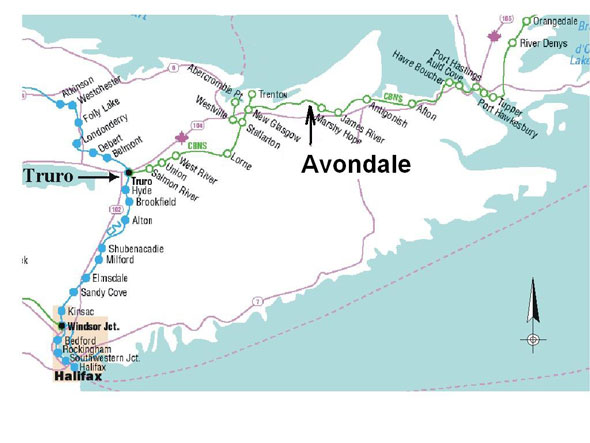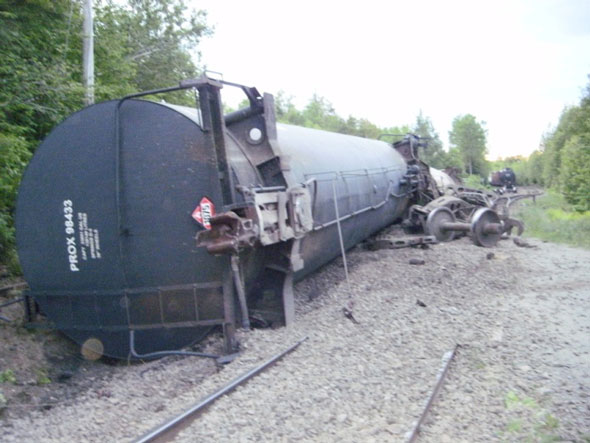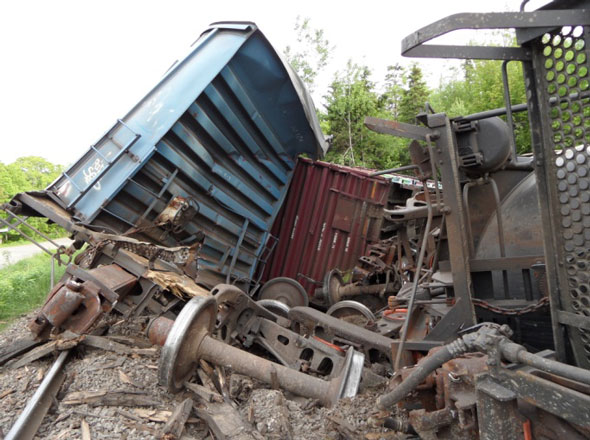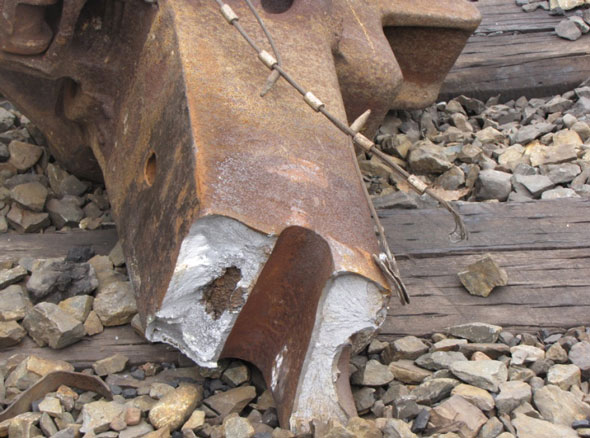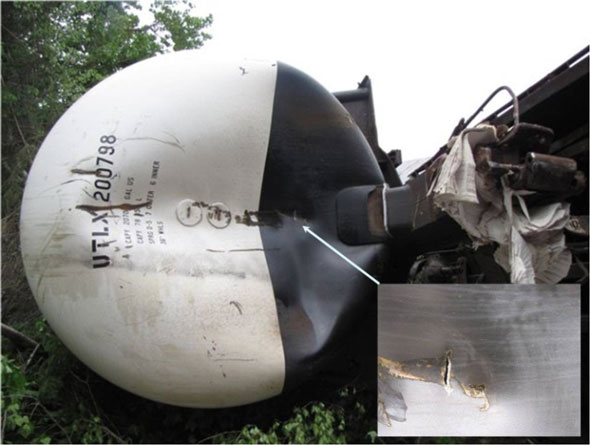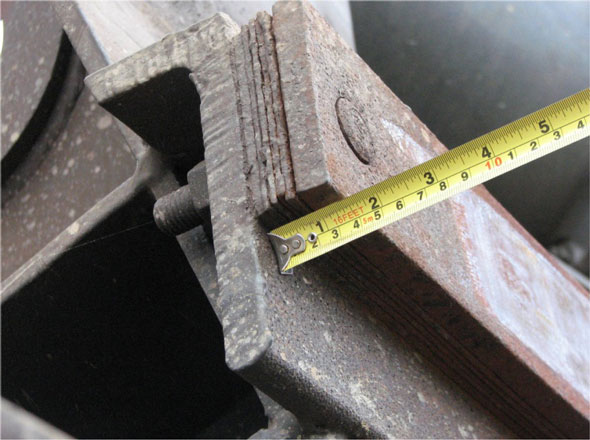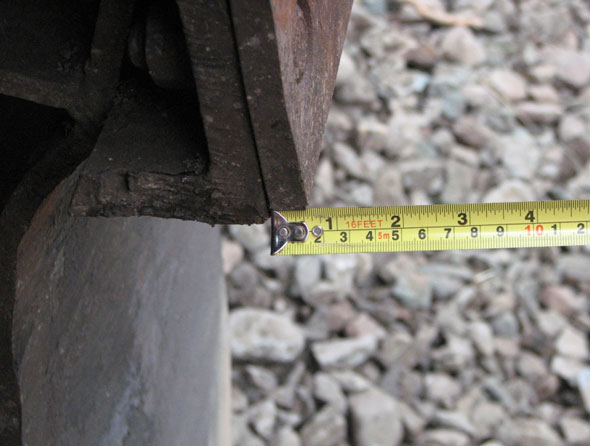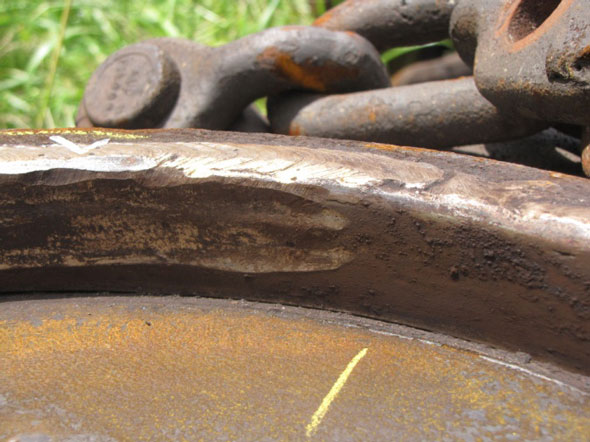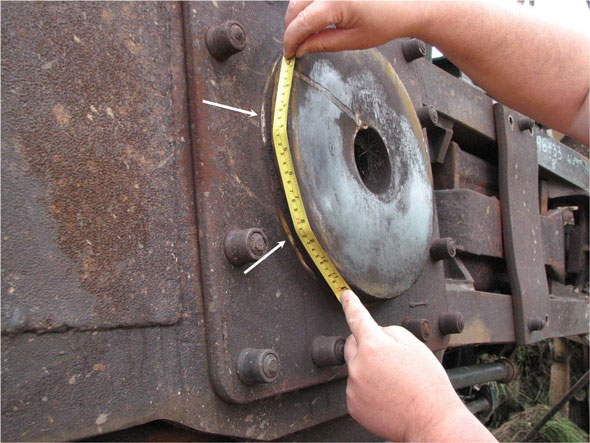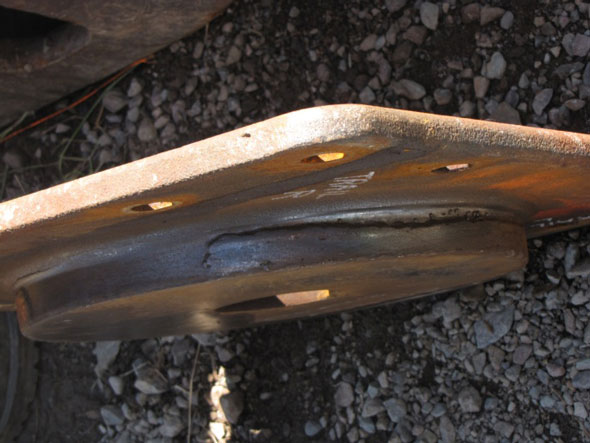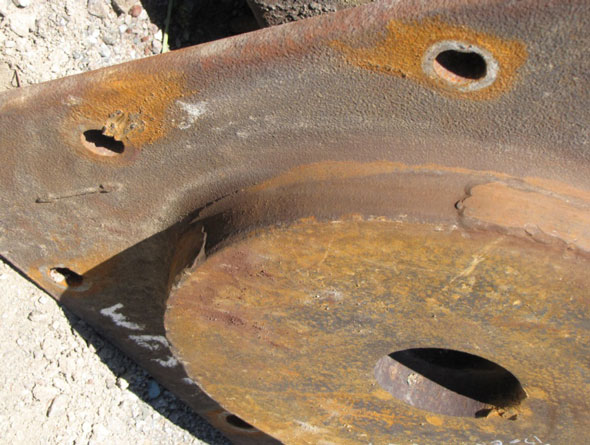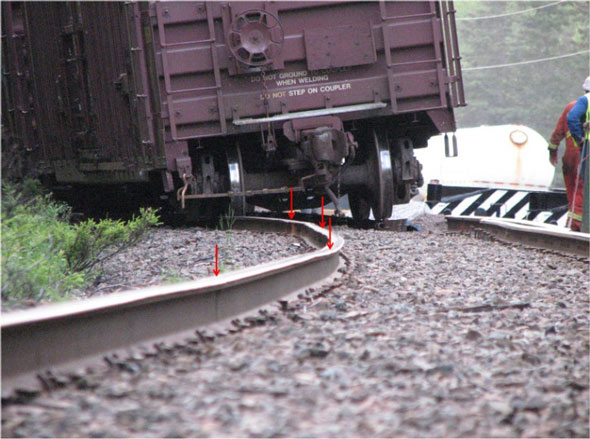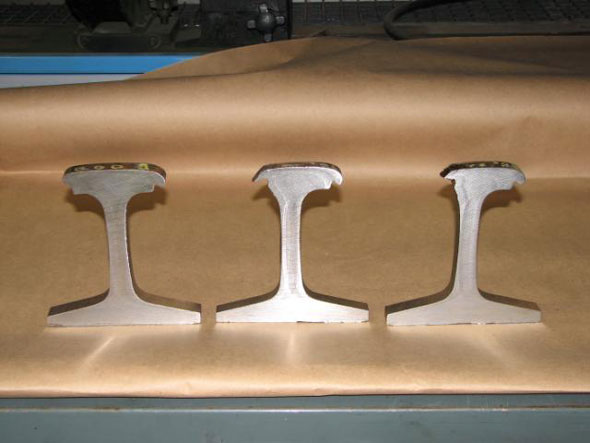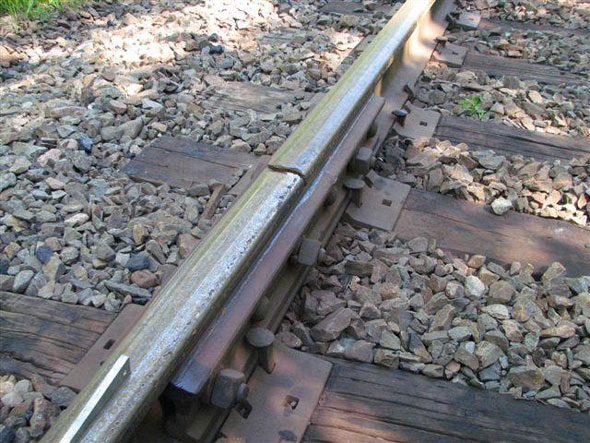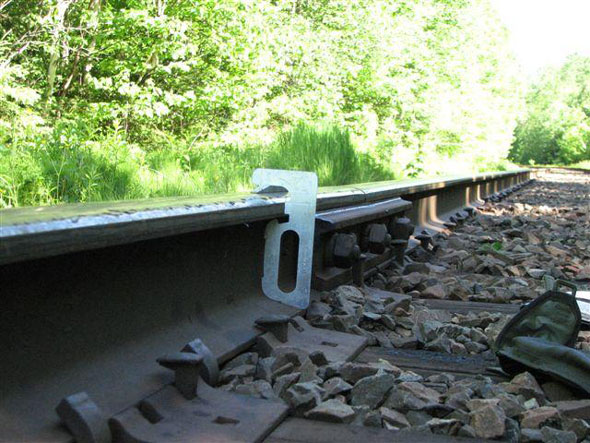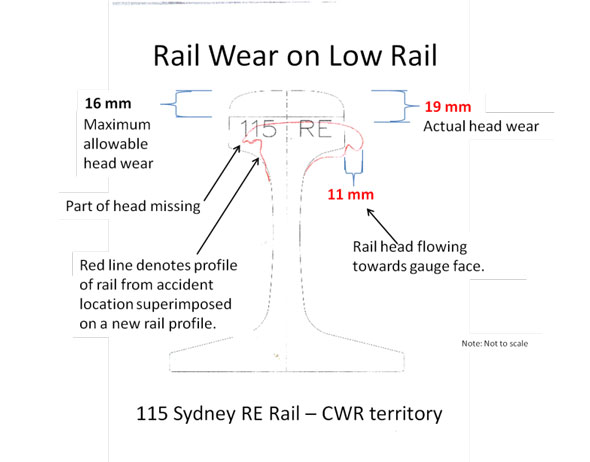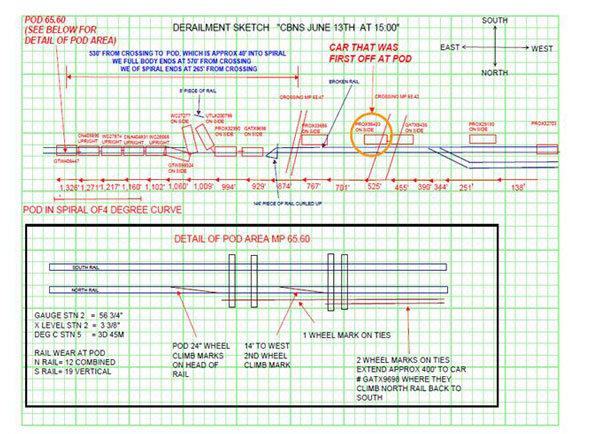Main-track derailment
Cape Breton and Central Nova Scotia Railway
Freight train no. 305-13
Mile 65.6, Hopewell Subdivision
Avondale, Nova Scotia
The Transportation Safety Board of Canada (TSB) investigated this occurrence for the purpose of advancing transportation safety. It is not the function of the Board to assign fault or determine civil or criminal liability. This report is not created for use in the context of legal, disciplinary or other proceedings. See Ownership and use of content. Masculine pronouns and position titles may be used to signify all genders to comply with the Canadian Transportation Accident Investigation and Safety Board Act (S.C. 1989, c. 3).
Summary
On 13 June 2010, at approximately 1359 Atlantic Daylight Time, a Cape Breton and Central Nova Scotia RailwayFootnote 1 (CBNS) freight train travelling westward at 24 mph derailed, damaging 15 rail cars, including 8 tank cars (7 loads of liquefied petroleum gas and 1 residue hydrogen peroxide). The derailment occurred at Mile 65.6 of the CBNS Hopewell Subdivision near Avondale, Nova Scotia. There were no injuries or release of dangerous goods. Ten residences were evacuated for approximately 1 week. The TSB investigated the derailment at the request of the provincial government.
Ce rapport est également disponible en français.
Factual information
On 13 June 2010, Cape Breton and Central Nova Scotia Railway (CBNS) freight train 305-13 (the train) departed Port Hawkesbury, Nova Scotia, en route to New Glasgow, Nova Scotia. The train, powered by 5 locomotives, comprised 62 loaded cars and 10 empty cars. The train weighed approximately 7760 tons and was roughly 4300 feet long.
The crew consisted of a conductor and a locomotive engineer. Both were positioned in the cab of the lead locomotive. They were qualified for their respective positions, met fitness and rest standards, and were familiar with the subdivision.
The trip from Port Hawkesbury was without incident until Mile 65.6 near Avondale in the county of Pictou (see Figure 1). At 1358:51,Footnote 2 as the train was travelling at 24 mph in throttle position No. 6 in a 4° left-hand curve in the direction of travel (second part of a reverse curve) on a descending grade of approximately 1.0%, it experienced a train-initiated emergency brake application. The train crew followed emergency procedures. The conductor inspected the train and determined that the 44th car from the head-end was dislodged from its trucks and that 14 cars (the 45th car to the 58th car) had derailed in the curve.
The weather was calm and clear with a temperature of 18°C.
Derailment site information
The accident occurred in a rural area and blocked a farm and a public crossing, which was equipped with flashing light signals and a bell that were damaged.
Approximately 1350 feet of track was extensively damaged or destroyed, including a turnout for a track adjacent to the main track.
Seven of the damaged cars were pressure tank cars loaded with liquefied petroleum gas (LPG) (Class 2.1, UN 1075), 6 of which (the 45th to the 50th cars) were rolled over onto their sides and extensively damaged. The tank cars were equipped with double shelf couplersFootnote 3 to minimize the risk of car separation and shell puncture during derailments. Three coupler shanks and the knuckle of the 45th, 46th and 48th cars broke in the post-derailment sequence. The fractured surfaces of the coupler shanks contained casting voids.
The other derailed tank car was a residue car, which last contained hydrogen peroxide stabilized (Class 5.1 (8), UN 2015). It was on its side and had sustained a head puncture (see Photo 1d). The remaining derailed cars were box cars loaded with paper products. They had run into the previously derailed cars, piled up and caused extensive equipment and track damage (see Photo 1b).
The derailment site was surveyed and the final positions of the derailed cars were identified (see Appendix A). Wheel marks were visible on top of the high (north) rail approximately 40 to 50 feet into the exit spiral of the 4° curve. These marks stretched over 400 feet westward, along the ties and base of the north rail, up to the zone where the track was destroyed.
Dangerous Goods
LPG is a flammable, colourless and odourless liquefied gas whose vapours are heavier than air. It is a highly dangerous fire hazard when exposed to a source of ignition, including static discharge. In gas or liquid form, is an irritant that can cause eye injury, frostbite, or respiratory problems. It is toxic to the central nervous system at high concentrations and can also act as an asphyxiant. In its presence, protective clothing, such as eye, skin, and respiratory protection (e.g. self-contained breathing apparatus), is recommended until the area is deemed safe using specialized gas detection equipment.
Hydrogen peroxide is used primarily as an oxidizing agent for many organic and inorganic compounds. It can react with many common metals and ignite combustible materials. Hydrogen peroxide can form explosive mixtures with some organic substances. It is also corrosive to human tissue, and its vapours are irritating to the eyes and mucous membranes. Hydrogen peroxide is heavier than water, but can be mixed with it in all proportions. Protective clothing, such as eye, skin, and respiratory protection (e.g. self-contained breathing apparatus), is recommended. In controlled environments, splash suits with hand and boot protection, along with face shields or full face mask respirators, may be used.
Tank Car – PROX 98433
The 47th car, PROX 98433 (see photo 1a), was most westerly derailed tank car with significant running gear damage. The car came to rest on its side, detached from its trucks, blocking the public crossing at Mile 65.42. The wheels, leading truck side frame and underside had extensive skidding and impact marks.
On 04 June 2010, PROX 98433 had been moved eastward through CN Moncton as a residue car en route for delivery to CBNS. PROX 98433 was a pressure tank car loaded with LPG and had a total weight of approximately 131 tons. A review of its certificate of construction (F-808812) and car registry (UMLER) specifications showed:
| Date built: | 04-81 |
|---|---|
| Length: | 68 feet |
| Capacity: | 33,851 gallons |
| Light Weight: | 100,300 lbs |
| Center of Gravity: | 89.76 in |
| Gross Rail Load: | 263,000 lbs |
| Tank Specification: | 112J340W |
| Truck Type: | Barber S-2 (3 11⁄16” spring travel, D-5) |
The car was observed with dissimilar body side bearing shims (left versus right) at each end of the car. The left side of the B-end (BL) (see Photo 2a) was shimmed approximately 7⁄8 inch while there were no shims on the right side (BR) (see Photo 2b). The left side of the A-end (AL) was shimmed at least 1⁄4 inch more than the right side (AR).
A review of train data was conducted to determine if the car body was in a leaning or twisted condition and, therefore, not evenly transferring weight to the wheels. Although an initial sample of the data suggested that this condition existed,Footnote 4 a more extensive review for 2008 to 2010, when the car was moving in both an empty and loaded condition, did not indicate sustained uneven weight transfer. The car owner had no record of the PROX 98433 having been involved in a prior accident.
The B-end truck center plate had abnormal side wall wear on the truck center plate bowl ring vertical surface (see Photo 3a and Photo 3b). The body center plate had its vertical surface built up with heavy weld (see Photo 3c and Photo 3d). The weld ends were not ground to match the original contour as per Association of American Railroads (AAR) and PROCOR Limited (PROCOR) requirements, which state:
Rule 60 - Field Manual of the AAR:
C. (1) Worn center plates may have wear surfaces built up by welding and then machined or ground smooth to proper contour [...]
The AAR Manual of Standards and Recommended Practices, Body Center Plates:
(b) Center plate bearing surface in contact with the car body and truck must be smooth within 250 micro inches [...]
PROCOR Repair Standard RES-076, Repair or Replacement of Center Plates:
V (B) 1(d) [...] grind or machine area to original contour.
Free rotation of the body center plate in the truck bolster bowl is critical to vehicle dynamic curving. If the rotation is blocked or restricted, the truck cannot negotiate freely along curved rail. The forced curving results in high lateral force and large angle of attack (AOA).
The car repair history showed that the body center plate work had been performed at PROCOR's Sarnia, Ontario, repair shop in August 2006. No repairs requiring truck removal were noted since then. Between the repair and accident dates, the car travelled approximately 45,000 miles.
An examination of PROCOR's repair records identified 27 other cars that had body center plate vertical surfaces built up with weld, all of which were repaired in Sarnia. At PROCOR, the repair of centre plates by welding is performed on limited occasions for non-standard plate geometry.
Dangerous Goods Tank Car Inspection
Section 7.1 (a) of the Railway Association of Canada (RAC) Freight Car Safety Rules, approved by Transport Canada (TC), states that:
Tank cars destined for loading with a dangerous good or other cars destined for loading of explosives shall be given a safety inspection at the nearest safety inspection location in the direction of travel prior to being placed for loading.
The LPG tank cars involved in the derailment were interchanged at Truro, Nova Scotia, from CN to CBNS for loading at Port Hawkesbury. They did not receive a safety inspection by a certified car inspector between Truro and Port Hawkesbury and only 1 received a pre placement inspection in Moncton, as outlined in the Railway Freight Car Inspection and Safety Rules (TC O-0-6.1- 25 October 1994). Their most recent safety inspections by a certified car inspector were as follows:
| Position | Car number | Load/empty | CCI location | Date |
|---|---|---|---|---|
| 44 | PROX 32703 | Empty | Montreal, Quebec | 03 June 2010 |
| 45 | PROX 29193 | Empty | Montreal, Quebec | 03 June 2010 |
| 46 | GATX 9436 | Empty | Moncton. New Brunswick | 06 June 2010 |
| 47 | PROX 98433 | Empty | Joffre, Quebec | 02 June 2010 |
| 48 | PROX 33686 | Empty | Toronto, Ontario | 06 June 2010 |
| 49 | GATX 9698 | Empty | Melville, Saskatchewan | 29 May 2010 |
| 50 | PROX 32990 | Empty | Toronto, Ontario | 06 June 2010 |
On the day of the occurrence, the loaded LPG cars were given a pre-departure inspection by the train crew for the hazardous conditions contained in Appendix 1 of the Freight Car Safety Rules (Pre-departure Inspection by Other Than a Qualified Car Inspector). No defects were noted during this inspection. Between Port Hawkesbury and Avondale, the train passed over a wayside inspection site at Mile 89.5. No alarms sounded.
Subdivision and track information
The Hopewell Subdivision, consisting of single main track that extends from Truro (Mile 2.3) to Havre Boucher, Nova Scotia, (Mile 116.2). Train movements are controlled by the Occupancy Control System as authorized by the Canadian Rail Operating Rules and supervised by a rail traffic controller (RTC) located in North Bay, Ontario. The track is classified as a Class 3 track, according to the Railway Track Safety Rules (TSR). The authorized speed between Mile 38.5 and Mile 66.0 was 35 mph. However, there was a temporary speed restriction of 25 mph due to tie conditions on a wooden railway bridge located at Mile 65.9.
In the area of the derailment, the track structure consisted of a mixture of bolted rail and continuous welded rail (CWR). The rail was Sydney RE 115-pound laid on double-shouldered tie plates secured with 3 spikes per tie. There were approximately 2980 hardwood ties per mile. The rail was box-anchored every 3rd tie. The ballast consisted mainly of crushed rock, was in good condition and showed no signs of fouling. The cribs were full and the shoulders were about 12 inches wide. There was no rail field lubricationFootnote 5 in use in this area, nor was it required by regulation.
Track inspections
The main track was last visually inspected by a track maintenance employee in a hi-rail vehicle on 11 June 2010, as prescribed by the TSR. The track was tested annually for rail flaws and geometry defects. An ultrasonic inspection of the rail was performed on 28 April 2010. A track geometry test was performed on 18 August 2009. Laser measurements were taken of the rail profile; no exceptions were noted in the derailment area during these inspections.
The main track was inspected by a TC Safety Officer between 15 June and 24 June 2009. No defects were noted in the derailment area.
Rail wear condition
The 4° derailment curve had a maximum superelevation of 3 7/8 inches, which corresponded to a balanced speedFootnote 6 of approximately 37 mph. For the speed at which this train was travelling (24 mph), the balanced superelevation would have been 1 1⁄2 inches. Therefore, the unbalanced superelevation was 2 3⁄8 inches, which was within the allowable limits.
CBNS's Standard Practice Circulars (SPCs) for track inspection and maintenance are similar to Class 1 Canadian railways. The SPC stipulates that, for 115 pound rail, maximum vertical wear limits when rail should be evaluated for removal are 8 mm for bolted rail and 16 mm for CWR. Beyond the 8 mm limit for bolted rail, high clearance joint bars are required to avoid wheel flange contact with the joint bar.
Post-accident track measurements for cross-level and gauge for 15 stations (measured 15 feet 6 inches ) east of the point of derailment were performed (see Appendix B). The examination of the rail revealed that the rail head was flattened and worn. The combined rail wear (i.e., head and gauge face wear ) was 12 mm on the high (north) rail and 19 mm of vertical head wear on portions of the low (south) rail of the derailment curve (see Photos 4 and Photo 5).
The nearest jointed rail was 820 feet east of the point of derailment. Several of the joint bars examined between Mile 65.6 and 65.9 showed contact marks from wheel flanges due to the severity of the head wear (see Photo 6a and Photo 6b).
Emergency response
Emergency response personnel at the occurrence site included the Royal Canadian Mounted Police (RCMP), the Barney's River Fire Department, the Bible Hill Special Hazards Response Unit, the LPG Emergency Response Team (from RST Industries, Saint John) and CBNS railway officials. As the initial isolation zone of 800 metres, stipulated by the Emergency Response Guidebook, extended beyond railway property, the local regional Emergency Measures Organization response plan was implemented.
Other responding agencies included the Railway Association of Canada, TC Dangerous Goods, Canutec, Environment Canada, the provincial Department of Environment and Labour, and other municipal, provincial, and federal representatives. Regular multi-agency briefings were conducted and incident action plans were developed and distributed. The overall emergency response was well coordinated and executed.
Tank car model simulation
The TSB Laboratory performed an analysis of tank car PROX 98433 using train dynamics model simulationFootnote 7 to determine the car's performance in the derailment curve, taking into consideration the restricted centre plate rotation, potentially dissimilar side bearing heights, and the unbalanced superelevation. The analysis determined that:
- the restricted center plate rotation contributed to the increase of the lateral force and increased the truck's angle of attack (AOA);
- the unbalanced superelevation of 2 3⁄8 inches would move the center of gravity inward and contribute to vertical unloading on the high rail; and
- dissimilar side bearing heights would increase the unloading on the high rail, the lateral force and the AOA. These increases would be to a smaller extent compared to the 2 factors above.
Analysis
The operation of the train met all company and regulatory requirements and did not play a role in the accident. The analysis will focus on the condition of PROX 98433 and its contribution to the accident, the track, and related repair and inspection practices.
The accident
The extensive marks on the wheels, leading truck side frame and underside of the car body of PROX 98433 are indicative of the car travelling a considerable distance in a derailed position, coming into contact with track components. As the wheel marks observed on the north side of the track were caused by a single truck, and the leading truck of PROX 98433 was the only one exhibiting damage consistent with a truck derailed to the north side, PROX 98433 was the first car to derail. The wheel marks on the gauge side and on the top of rail at the POD show that the leading truck climbed the rail and then derailed, damaging the track and causing the derailment of the other cars.
The analysis of tank car PROX 98433 performed by the TSB Laboratory to determine the car's performance in the derailment curve revealed that the restricted center plate rotation and the unbalanced superelevation increased the lateral force, the AOA and the vertical unloading on the high rail. Increased wheel AOA can result in wheel climb derailments at reduced L/V values, particularly in the presence of dry unlubricated rail. The wheel climb occurred as a result of a stiff truck condition, which increased lateral forces. Reduced vertical forces on the unlubricated high rail as the train was travelling at an under balance speed also contributed to the wheel climb.
Effect of restricted center plate rotation
Repairs made to the body centre plates of tank car PROX 98433 by welding the worn vertical surfaces were permitted by AAR and PROCOR rules. However, the approved procedure of machining or grinding smooth the welds to proper contour was not followed. Because the weld was tougher than the truck centre plate bowl, the regular in-train forces led to the formation of wear gouges in the longitudinal axis of the truck centre plate bowl over time. Any out of round condition can restrict the rotational movement of the 2 mating centre plates, resulting in increased lateral forces in curved sections of track and increased AOA.
Effect of unbalanced superelevation
The slow order on the wooden bridge required that the train be operated at a slower speed through the curve than that for which the track was originally designed. When there is unbalanced superelevation, there is a transfer of loading from the high rail to the low rail. Because the train was operating at an unbalanced speed, the vertical loading on the high rail was reduced as the cars negotiated the curve. Furthermore, the location of the POD in the exit spiral contributed to additional vertical unloading on the high rail. Because of the track warp inherent in spirals (i.e., difference in superelevation between the leading and trailing trucks) and that pressure tank cars are torsionally rigid, these cars are susceptible to wheel unloading in exit spiral locations. Although the amount of underbalanced superelevation was within safety norms and the speed of the train was within allowable limits, the slow train speed contributed to the vertical unloading on the high rail where the wheel climb occurred.
Broken coupler shanks
The 45th, 46th and 48th cars had broken coupler shanks. The shanks on these double shelf couplers broke, and the tank cars overturned and were subjected to additional damage. Once separated, the protection afforded by the double shelf couplers against head punctures was reduced.
Although the 3 coupler shank failures were not considered to be contributory factors in this accident, there were voids in some of the castings (See Photo 1c). The presence of severe porosity in coupler castings increases the likelihood of train pull-apart and poses a risk to safe train operations, particularly those involving dangerous goods.
Safety inspection of Dangerous Goods cars
Only 1 of the tank cars involved in the derailment received its safety inspection by a certified car inspector at the nearest safety inspection location in the direction of travel prior to being placed for loading, as required by the Freight Car Safety Rules. One LPG tank car was last safety inspected in Melville, Saskatchewan, more than 2500 miles before the point of loading. In the absence of a robust safety inspection of dangerous goods tank cars prior to being placed for loading, safety defects may go undetected, increasing the risk to safe train operations.
Safety inspections of railway cars are important to identify components, such as wheels, couplers, draft gears and running gear, that are defective or worn to condemning limits. However, there are some mechanical components whose condition cannot be identified by visual inspections performed on stationary railway cars while in a train yard. In this occurrence, the contact surfaces of the car and truck centre plates would not have been visible to a certified car inspector with the car body positioned on its trucks. A certified car inspector would not have been able to identify the defective welds and wear condition of the tank car's centre plate components during the safety inspection. These types of conditions can only be identified when the tank car is on a shop repair track with its trucks removed.
PROX 98433 had not experienced any in-service related problems requiring shop repair track attention and truck removal since 2006. Therefore, the condition of its welded centre plates went undetected.
Excessive rail wear
Due to the extent of the rail head wear, wheel flanges were striking some rail joint bars east of the POD. Although these marks were clearly visible, they were not identified during inspections and no corrective action was taken. Maximum rail vertical wear limits and the use of high-clearance joint bars are intended to prevent such high impact forces. When head wear exceeds 8 mm on 115-pound rail and high clearance rail joint bars are not used, there is a risk of rail joint bars being struck by wheel flanges, which can result in wheel and rail failures, increasing the risk of derailment.
Although CBNS had maximum prescribed rail vertical wear limits when rail should be evaluated for removal, there were portions of rail in the derailment area that exceeded those limits. Because rail wear results in an increase in stresses and reduces a rail's fatigue life, a rail becomes more susceptible to the development and spread of cracks posing a risk of derailment.
Track geometry inspections were performed by CBNS and TC. However, the excessive rail head wear was not identified and corrected. Rail wear is normally accurately measured by the track geometry car used by CBNS. However, due to the severely worn and deformed condition of the rail head, a correct profile was not recorded at this location and the maintenance crews were not alerted to the severity of wear (see Figure 2).
The railway relied on the use of this type of technology to identify problem areas and to focus its maintenance efforts. Information provided by the track geometry inspection cannot be solely relied upon to identify rail that is worn to the extent that it poses a risk to safe operations. The data must be used in conjunction with detailed and comprehensive visual track inspections. Considering that many railways are placing an increasing reliance on the use of track geometry inspection technology to focus their maintenance efforts, some railways may not be aware of the limitations inherent in its use to identify rail worn to the extent that it poses a risk to safe operations.
The following TSB Laboratory report was completed:
LP 166/2010 – Analysis of derailed car PROX 98433
This report is available upon request from the Transportation Safety Board of Canada.
Findings
Findings as to causes and contributing factors
- The train derailed when the leading truck of tank car PROX 98433 climbed the high rail while negotiating a curve as a result of a stiff truck condition, which increased lateral forces.
- Reduced vertical forces on the unlubricated high rail as the train was travelling at an under balance speed also contributed to the wheel climb.
- The stiff truck condition was created when the welds of the body centre plate of tank car PROX s98433 were not machined or ground smooth during the 2006 repair.
Finding as to risk
- The presence of severe porosity in coupler castings increases the likelihood of train pull apart and poses a risk to safe train operations.
- In the absence of a robust safety inspection of dangerous goods tank cars prior to being placed for loading, safety defects may go undetected, increasing the risk to safe train operations.
- Cars in service with stiff trucks can remain undetected and generate high lateral loads on track infrastructure, increasing the risk of derailments.
- Because rail wear results in an increase in stresses and reduces a rail's fatigue life, a rail becomes more susceptible to the development and spread of cracks, posing a risk of derailment.
- When head wear exceeds 8 mm on 115-pound rail and high clearance rail joint bars are not used, there is a risk of rail joint bars being struck by wheel flanges, which can result in wheel and rail failures and increase the risk of derailment.
Safety action taken
On 22 September 2010, the TSB issued a Rail Safety Information Letter (RSI-05/10), titled Rail Wear and Non-use of High-Clearance Joint Bars. The letter referenced previous safety action issued by the TSB on the use of bolted rail with head wear beyond prescribed limits without high clearance joint bars. Considering that rail joint bars struck by moving equipment can cause sudden fractures of either the rail joint itself or a wheel flange, RSI-05/10 stated that Transport Canada (TC) and the Rail Association of Canada (RAC) may wish to inform other railways about the procedures for the inspection and replacement of worn rail, and the use of high-clearance rail joint bars in areas where rail head wear exceeds limits and results in wheel flange contact with standard joint bars.
Also, on 22 September 2010, the TSB issued Rail Safety Advisory letter (RSA-03/10), titled Reliability of Rail Profiles Measured by Geometry Cars. The letter stated that, at least in this specific situation, the information provided by a geometry car could not be solely relied upon to identify rail that was worn to the extent that it posed a risk to safe operations. The letter also stated that the data must be used in conjunction with detailed and comprehensive track inspections.
In October 2010, TC responded by saying that the Track Safety Rules are being reviewed for possible amendments, including the provision dealing with rail wear. TC also advised that the potential issues associated with the reliability of rail profiles measured by geometry cars will be discussed with the railways.
The province of Nova Scotia forwarded the TSB Information Letter and TSB Advisory Letter to Cape Breton and Central Nova Scotia Railway (CBNS) for its attention. CBNS advised that, under its rail replacement program, 80% of the 576 joint bars on its line have been changed and that the use of high clearance joint bars in some locations has been instituted. A rail inspection vehicle was leased in June 2011 to inspect the rail. All rail identified by this car was replaced. In addition, a yearly maintenance program has been developed to ensure that rails are being identified, evaluated and changed on a proactive basis. Track inspections are being performed twice a week on all main line track.
On 20 October 2011, the TSB issued another Rail Safety Information Letter (RSI-12/11), titled Safety Inspection of Dangerous Goods Cars. According to the letter, although a CBNS document stated that all dangerous goods empties interchanged to CBNS at Truro were to be given a safety inspection at Moncton, 6 out of 7 tank cars involved in the derailment (all loaded with liquefied petroleum gas on CBNS lines) were not. There were no records of such key inspections being exchanged between the railways prior to the cars being placed for loading. The Rail Safety Information Letter stated that the number of tank cars not inspected as per the Freight Car Safety Rules suggests that there may be insufficient emphasis on those specific inspection requirements.
PROCOR reviewed the truck performance of the 27 identified cars via the Equipment Health Management System (EHMS) of alerts. EHMS includes a facility to report on truck curving performance via Gage Spread Force (GSF) and Lead Axle High Rail L over V Ratio. To date, none of the 27 identified cars have been subject to Warning or Condemnable alert status. PROCOR has also initiated a shop program and is progressing with its inspection of all of these cars. No conditions similar to car PROX 98433 have been identified. They have also reviewed the correct repair procedures with their shop staff.
Appendices
Appendix A – Derailment schematic showing approximate position of derailed cars
Appendix B – Post-accident track measurements
| Station no (15′6″) |
Alignment mid-ordinate (62′ chord) |
Gauge | Loaded gauge |
Light x-level |
Loaded x-level |
|---|---|---|---|---|---|
| POD | |||||
| 1 | 57 | 57 | 3 5⁄8 | ||
| 2 | 57 | 56 5⁄8 | 3 3⁄8 | 3 1⁄8 | |
| 3 | 56 1⁄2 | 56 9⁄16 | 3 7⁄16 | 3 1⁄2 | |
| 4 | 56 7⁄8 | 56 15⁄16 | 3 3⁄16 | 3 3⁄8 | |
| 5 | 3D45M | 56 1⁄2 | 56 3⁄4 | 3 3⁄16 | 3 1⁄4 |
| 6 | 3D45M | 56 5⁄8 | 56 7⁄8 | 3 7⁄8 | 3 13⁄16 |
| 7 | 4D | 56 1⁄2 | 56 7⁄8 | 3 3⁄8 | 3 3⁄8 |
| 8 | 4D | 56 1⁄2 | 56 3⁄4 | 3 3⁄8 | 3 3⁄8 |
| 9 | 4D | 56 1⁄2 | 56 3⁄4 | 3 3⁄8 | 3 1⁄4 |
| 10 | 3D45M | 56 3⁄8 | 56 1⁄2 | 3 3⁄8 | 3 7⁄16 |
| 11 | 4D | 56 3⁄8 | 56 1⁄2 | 3 3⁄8 | 3 3⁄8 |
| 12 | 4D | 56 5⁄8 | 56 3⁄4 | 3 5⁄16 | 3 5⁄16 |
| 13 | 4D | 56 1⁄2 | 56 3⁄4 | 3 1⁄2 | 3 1⁄2 |
| 14 | 3D30M | 56 5⁄8 | 56 3⁄4 | 3 1⁄2 | 3 9⁄16 |
| 15 | 4D | 56 1⁄2 | 56 3⁄4 | 3 1⁄2 | 3 1⁄2 |
Note: Rail rolled slightly from derailment starting at Station No 1.
This report concludes the Transportation Safety Board's investigation into this occurrence. Consequently, the Board authorized the release of this report on .
